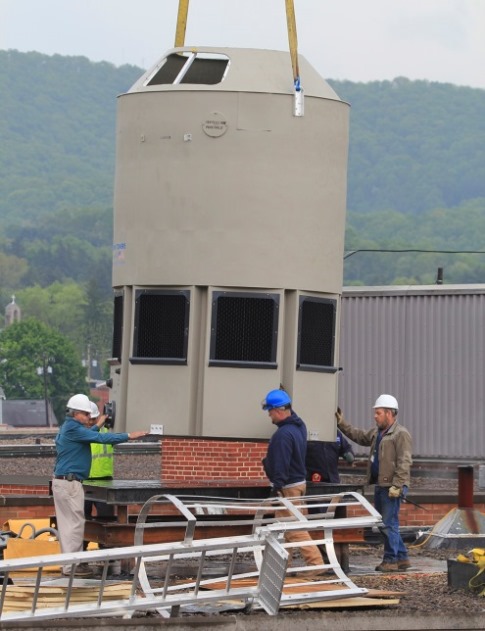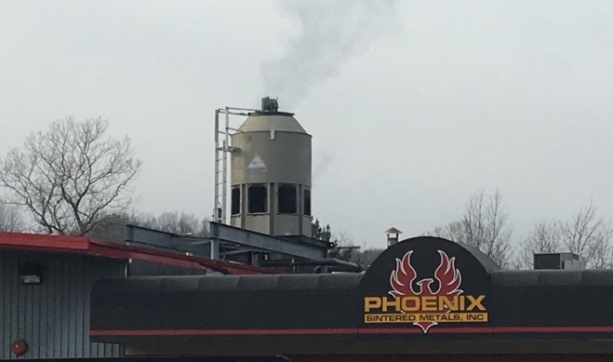For metalworking operations using extreme heat, recent case studies have shown engineered plastic cooling towers to be a viable option to provide effective cooling without corroding, according to U.S. tower manufacturer Delta Cooling Towers (Roxbury Township, New Jersey).
Sintering operations in powder metal manufacturing are particularly dependent on this technology, the company explains. Sintering is a process by which metal particles are chemically bonded and formed by heat and pressure without reaching total liquefaction. To accomplish this, powdered metal and alloy mixtures are compacted into near-net shapes, typically using a high-pressure press. The compacted material is then placed in a sintering furnace to improve the bonds and harden the material to the desired final specifications.
With temperatures in the “high heat” section of a sintering furnace reaching several thousand degrees Fahrenheit, the parts must be dramatically cooled before they can be handled safely by operators. To expedite the temperature reduction process, cooling towers are often used to circulate water through a jacket that cools the air surrounding the part.
Many of these cooling towers are constructed of galvanized steel. However, those parts can be susceptible to corrosion and rust, which can lead to unplanned maintenance.
Water Leak in Corroded Existing Tower
For powdered metal parts manufacturer Phoenix Sintered Metals, LLC (Brockway, Pennsylvania), a galvanized cooling tower the company inherited when it purchased its facility was so corroded it was losing water and a water treatment chemical at a high rate. The company tried to patch the tower, but that only slowed the problem. It did not stop it.
“We were losing a lot of water out the bottom of the cooling tower on a daily basis because of the leaks,” says Josh Crawford, maintenance supervisor at the metal part manufacturer.
According to Delta, factors contributing to corrosion in metal towers like the one in Pennsylvania case include salt air, a caustic atmosphere (found at many industrial sites), minerals in hard water, and the water's pH level.
“We were spending a lot of time trying to patch cracks in the floors and we were able to contain it a little bit, but never able to completely stop it,” Crawford says. “As time went on, the cooling tower continued to rust and the problem became worse.”
The cooling tower, having been relocated from a second location upon Phoenix’s acquisition of the business, was also oversized for the current site by about 60%, Crawford explains. Although this did not impact the unit’s cooling capability, the oversized unit added to his company’s operating costs due to the extra electricity required to operate fans and pumps, as well as water replacement and specialized water chemistries.
HDPE Tower Recommended as Alternative
 Seeking a more permanent solution, Crawford asked ProChemTech, a company that provides cooling water chemistry, systems design, and engineering solutions, to inspect and evaluate his company’s system.
Seeking a more permanent solution, Crawford asked ProChemTech, a company that provides cooling water chemistry, systems design, and engineering solutions, to inspect and evaluate his company’s system.
“The previous ownership used that tower for quite a few years,” says Bill Foringer, plant manager at ProChemTech. “Initially, [Phoenix Sintered] considered refurbishing it, but that isn’t cost effective when you need new fan, motor, base, and pan—it can get quite expensive. So, at that point, we started looking at new cooling towers.”
When asked to make a recommendation, Foringer’s company suggested a high-density polyethylene (HDPE) plastic cooling tower. Made from corrosion-resistant engineered plastic, the seamless “one piece” shell design has no joints, seams, panels, gaskets, bolts, fasteners, or caulking like conventional towers. According to the tower manufacturer, this can significantly reduce maintenance.
“What drew our attention right away is that we wouldn’t have to worry about the rusting of the shell,” Crawford says. “Granted, had we purchased a new, galvanized tower, it wouldn’t require much upkeep at first. But eventually, it would get to that point where we would have those same issues.”
The design selected by the consultant features a counter-flowing tower design available in single module capacities from 55 to 250 cooling tons.

Crawford was also impressed by the cost and length of warranty for the plastic cooling tower. Because HDPE towers are resistant to corrosive products, they can provide a much longer service life.
“The cooling tower was a little cheaper and had a better warranty as well,” Crawford says.
The unit was installed in July 2016 by a local contractor recommended by the consultant. While the tower remains in the first year of its lifecycle, Crawford says early results appear promising.
Source: Delta Cooling Towers, Inc., deltacooling.com.